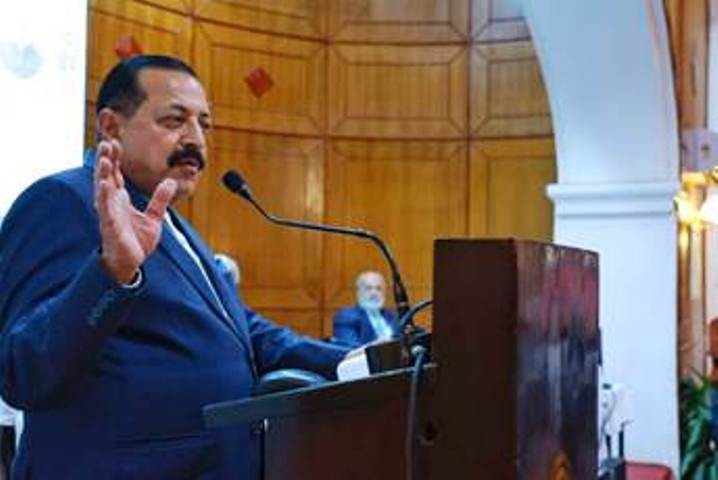Dr. Jitendra Singh Orders Nationwide Security Review of Scientific Facilities
India’s scientific institutions, particularly those in volatile and border-adjacent zones, are being fortified to withstand both internal and external threats.

- Country:
- India
In a significant move aimed at reinforcing the safety and preparedness of India's scientific infrastructure, Union Minister of State (Independent Charge) for Science and Technology, Earth Sciences, and Personnel, Dr. Jitendra Singh, convened a high-level review meeting today. The objective was to assess and upgrade security protocols at scientific and technical installations, especially those located in sensitive border areas such as Jammu & Kashmir (J&K), Punjab, Chandigarh, and the northwestern parts of Rajasthan and Gujarat.
The meeting, attended by senior officials and heads of various scientific departments, was convened in light of the prevailing security concerns and the strategic vulnerability of research institutions situated in frontier zones. Dr. Singh underscored the pivotal role played by these facilities in bolstering national resilience through their contributions to weather forecasting, natural disaster mitigation, critical research, and innovation.
Security Upgrades Across Strategic Installations
Among the key institutions identified for immediate attention were:
-
CSIR-Indian Institute of Integrative Medicine (IIIM), Jammu
-
CSIR-Central Scientific Instruments Organisation (CSIO), Chandigarh
-
CSIR-Central Leather Research Institute (CLRI), Jalandhar
-
CSIR-Institute of Microbial Technology (IMTECH), Chandigarh
-
DBT-Biotech Research Innovation Council (BRIC) – NABI, Mohali
-
Indian Meteorological Department (IMD) centers in Srinagar and Leh
-
Earth Sciences Research Stations in Ladakh and surrounding areas
These institutes, many of which fall under the Council of Scientific and Industrial Research (CSIR), Department of Biotechnology (DBT), Indian Meteorological Department (IMD), and the Ministry of Earth Sciences, are recognized as crucial nodes in India’s scientific ecosystem. The Minister emphasized the need to elevate their protective infrastructure to mitigate risks arising from their geographical positioning and growing security challenges.
SOPs, Coordination, and Internal Readiness
Dr. Singh directed all institutions to immediately review their existing security measures in coordination with local district administrations. In line with this, every scientific body has been mandated to develop and circulate updated Standard Operating Procedures (SOPs) focused on emergency response and evacuation protocols. This includes active engagement with law enforcement agencies to ensure seamless crisis management.
Furthermore, internal readiness was brought to the forefront. Institutes have been told to reinforce internal vigilance, including the enforcement of staff-specific “Do’s and Don’ts,” in order to minimize vulnerabilities. In addition, mock drills, evacuation rehearsals, and sensitization sessions on emergency preparedness are to be institutionalized as regular activities on all campuses.
Morale and Continuity of Research
Addressing concerns related to ongoing academic and research programs, Dr. Singh ordered a postponement of all examinations and research proposal deadlines to accommodate students and researchers who may have traveled to their home states amidst the current situation. He assured that no student or research fellow should face academic disadvantage due to preventive security actions.
To strengthen morale and solidarity within the scientific community, the Minister encouraged the organization of blood donation camps and volunteer-driven safety workshops involving students, faculty, and research staff.
Nationwide Coordination and Asset Mapping
One of the key outcomes of the meeting was the directive to prepare a comprehensive inventory of all technical and scientific facilities—especially those located in sensitive regions. This inventory is to be shared with national security agencies to facilitate coordinated safeguarding strategies and risk mitigation planning.
Dr. Singh emphasized, “Our scientific institutions are the backbone of national resilience. At a time like this, we must ensure they are secure, well-coordinated, and prepared for every possible eventuality.”
High-Level Participation and Strategic Decisions
The review meeting saw participation from prominent officials, including:
-
Dr. Abhay Karandikar, Secretary, Department of Science and Technology (DST)
-
Dr. Rajesh Gokhale, Secretary, Department of Biotechnology (DBT)
-
Dr. N. Kalaiselvi, Director General, CSIR & Secretary, DSIR
-
Mrutyunjay Mohapatra, Director General, IMD
-
Senthil Pandian, Joint Secretary, Ministry of Earth Sciences
-
Directors of autonomous scientific institutes across the country (many joining via video conferencing)
These leaders collectively presented situational updates, suggested security improvements, and proposed morale-enhancing measures. Dr. Singh lauded the proactive participation and reiterated the importance of constant liaison between scientific bodies and district administrations.
The Way Forward
India’s scientific institutions, particularly those in volatile and border-adjacent zones, are being fortified to withstand both internal and external threats. The Government’s focus on blending scientific excellence with robust security demonstrates a clear commitment to not only innovation and research but also to national integrity and institutional safety.
The implementation of these comprehensive security strategies is expected to fortify the country’s preparedness in the face of evolving geopolitical challenges.
ALSO READ
Cross-Border Tensions Escalate in Jammu & Kashmir Amid Renewed Shelling
Cross-Border Tensions Escalate: Jammu & Kashmir on High Alert
Compensation Announced for Victims of Shelling in Jammu & Kashmir
Leh-Manali Highway Reopens, Strengthening Ladakh's Connectivity
Security Forces Neutralize Terrorists in Jammu & Kashmir Encounter










